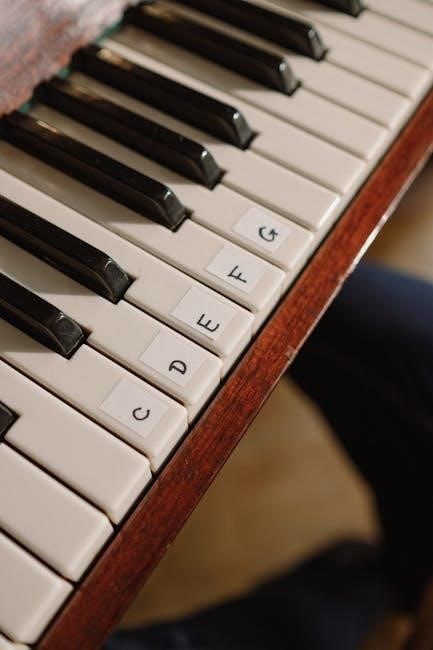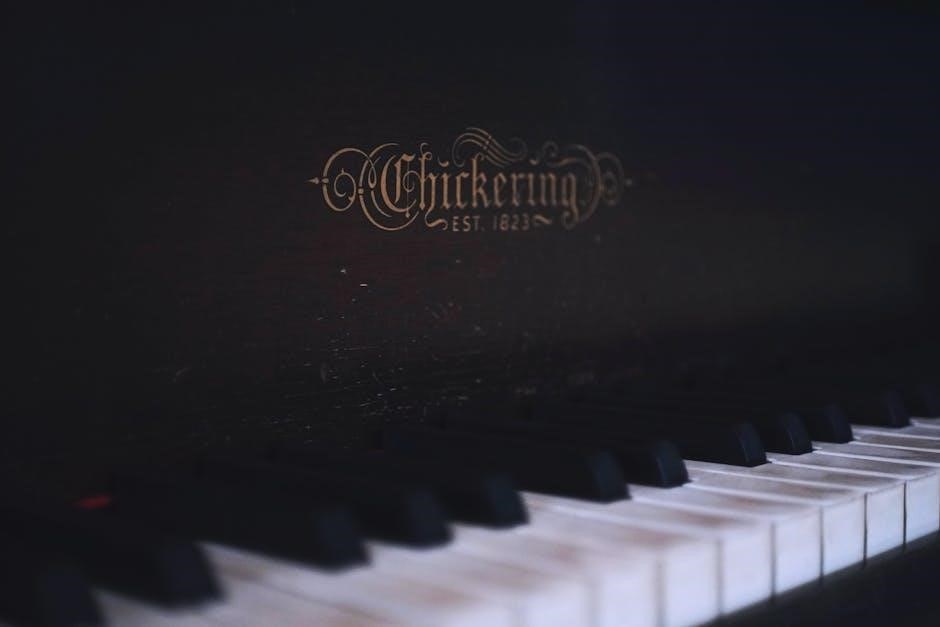Welcome to the world of jazz piano chords! These chords form the foundation of jazz harmony‚ offering rich‚ complex sounds through extensions like 7ths and altered tones․ PDF resources provide essential charts for learning these voicings‚ enabling musicians to explore improvisation and composition effectively while mastering jazz theory and practice techniques․

Types of Jazz Piano Chords
Jazz piano chords include Major 7th‚ Minor 7th‚ Dominant 7th‚ Half-Diminished‚ and Altered Dominant chords․ These extensions add color and complexity to harmonies․ PDF resources provide charts for each type‚ aiding learning and practice․
2․1 Major 7th Chords
A Major 7th chord is a fundamental chord in jazz‚ consisting of a root‚ major third‚ perfect fifth‚ and major seventh․ It creates a bright‚ rich‚ and harmonically stable sound․ For example‚ a C Major 7th chord includes the notes C‚ E‚ G‚ and B․ These chords are widely used in jazz standards and popular music to establish tonal harmony․ Jazz piano chord PDFs often include Major 7th chords in all keys‚ making them essential for practice and performance․ Understanding and memorizing these voicings is crucial for building a strong foundation in jazz piano․ They are also versatile‚ often appearing in chord progressions and improvisational contexts․ Practicing Major 7th chords in various inversions and rhythms will enhance your ability to play smoothly and confidently․
2․2 Minor 7th Chords
A Minor 7th chord is a cornerstone of jazz harmony‚ consisting of a root‚ minor third‚ perfect fifth‚ and minor seventh․ For example‚ a C Minor 7th chord includes the notes C‚ Eb‚ G‚ and Bb․ These chords evoke a somber‚ introspective sound and are frequently used in ballads and slower jazz pieces․ Jazz piano chord PDFs often highlight Minor 7th chords‚ providing clear voicings and inversions for practice․ Mastering these chords is essential for playing jazz standards and improvising over minor keys․ They are also versatile‚ appearing in various musical contexts‚ from bebop to contemporary jazz․ Practicing Minor 7th chords in all keys and inversions will strengthen your harmonic understanding and enhance your ability to play with emotional depth and nuance․
2․3 Dominant 7th Chords
A Dominant 7th chord is a fundamental element in jazz harmony‚ consisting of a root‚ major third‚ perfect fifth‚ and minor seventh․ For example‚ a C Dominant 7th chord includes the notes C‚ E‚ G‚ and Bb․ These chords are highly versatile and create a strong sense of harmonic tension‚ often resolving to a tonic chord․ In jazz‚ Dominant 7th chords are commonly used in blues and swing music‚ providing a rich‚ dynamic sound․ Jazz piano chord PDFs often feature these chords prominently‚ offering various voicings and inversions for practice․ Mastery of Dominant 7th chords is essential for playing jazz standards and improvising over dominant harmonies․ They are also a stepping stone for more complex chords‚ such as altered dominants‚ which add further color and tension to musical progressions․ Practicing these chords in all keys will enhance your harmonic understanding and improvisational skills․
2․4 Half-Diminished Chords
A half-diminished chord‚ often symbolized as m7b5‚ consists of a root‚ minor third‚ diminished fifth‚ and minor seventh․ For example‚ a C half-diminished chord includes C‚ Eb‚ Gb‚ and Bb․ These chords are frequently used in jazz to create tension and add color to harmonic progressions․ They are particularly common in modal interchange and minor key settings‚ serving as the ii chord in a minor key or as a lead-in to a dominant chord․ Jazz piano chord PDFs often include half-diminished voicings‚ providing players with various inversions and contexts for practice․ Understanding and mastering these chords is crucial for improvisation and composition‚ as they bridge the gap between minor and dominant harmonies․ Regular practice with these chords will enhance your ability to navigate complex progressions and add depth to your playing․
2․5 Altered Dominant Chords
Altered dominant chords are a cornerstone of jazz harmony‚ adding rich chromaticism to musical progressions․ These chords are based on the dominant 7th but with altered extensions‚ such as a flatted or sharpened 5th‚ 9th‚ or 11th․ They are often used to create tension leading to a resolution‚ typically before a major or minor chord․ For example‚ an altered C7 could resolve to F major or F minor․ Common alterations include the flat 9‚ sharp 9‚ flat 5‚ and sharp 5‚ each offering a unique color․ Jazz piano chord PDFs often include these voicings‚ providing players with multiple variations and keys․ Mastering altered dominants is essential for advanced harmonic techniques like modal interchange and reharmonization․ Regular practice with these chords will enhance your ability to navigate complex progressions and add sophistication to your playing․
How to Read Jazz Chord Symbols
Mastering jazz chord symbols is essential for interpreting harmony․ Symbols like Maj7‚ m7‚ and 7 indicate chord quality and extensions․ Jazz piano chord PDFs often include these notations‚ helping musicians decode and play complex progressions accurately․
3․1 Understanding Chord Notation
Understanding chord notation is crucial for interpreting jazz harmony․ Chord symbols provide essential information about root notes‚ quality‚ and extensions․ For example‚ Cmaj7 indicates a C major triad with a major 7th‚ while C7 denotes a dominant 7th chord․ Jazz piano chord PDFs often include these notations‚ offering a visual guide to complex voicings and progressions․ These resources are invaluable for musicians aiming to decode and play intricate harmonies․ By studying these charts‚ pianists can grasp the nuances of jazz notation‚ enabling them to perform and improvise with confidence․
3․2 Common Jazz Chord Symbols
Jazz relies on a variety of chord symbols to convey harmonic complexity․ Common symbols include Maj7‚ 7‚ m7‚ and °7‚ each representing distinct chord qualities․ For instance‚ Cmaj7 denotes a major 7th chord‚ while C7 signifies a dominant 7th․ Jazz piano chord PDFs often list these symbols‚ providing clear diagrams for pianists to learn and apply them․ These resources are especially useful for understanding extended chords like alt and add9‚ which are frequently used in jazz․ By familiarizing yourself with these symbols‚ you’ll be able to interpret and play complex jazz harmonies with precision and confidence‚ enhancing your ability to improvise and accompany effectively․

Learning Jazz Piano Chords
Learning jazz piano chords begins with understanding 7th chords and extensions․ Memorization and consistent practice exercises are key․ Jazz piano chord PDFs offer organized charts to master essential voicings and progressions․
4․1 Memorization Techniques
Memorizing jazz piano chords requires a systematic approach․ Start by focusing on common 7th chords‚ as they form the basis of most progressions․ Use chord charts from jazz piano PDFs to visualize and organize the voicings․ Break chords into smaller components‚ such as root‚ 3rd‚ and 7th‚ to simplify the learning process․ Associate each chord with its function within a key or scale to enhance retention․ Practice chords in all 12 keys to develop a deeper understanding of harmony․ Use spaced repetition and flashcards to reinforce memory․ Record yourself playing and track your progress․ Finally‚ apply chords in real-time by improvising or accompanying melodies‚ making the process engaging and practical․
4․2 Effective Practice Exercises
Effective practice exercises are crucial for mastering jazz piano chords․ Begin with finger independence drills to build dexterity․ Practice chord scales in all keys‚ focusing on smooth transitions․ Arpeggiate chords to internalize their structures․ Play chords in slow tempos‚ gradually increasing speed․ Use PDF charts to visualize voicings and ensure accuracy․ Incorporate common progressions like the 2-5-1 to apply chords in context․ Record your sessions to track progress and identify areas for improvement․ Finally‚ practice improvising over chord changes to integrate theory with creativity‚ reinforcing your understanding of jazz harmony and its practical application․

The Importance of Jazz Piano Chord PDFs
Jazz piano chord PDFs are invaluable resources for musicians seeking to master chord voicings and progressions․ These documents provide comprehensive charts of essential chords‚ including major 7th‚ minor 7th‚ dominant 7th‚ and altered chords‚ organized by root notes․ They often include exercises and examples to help players practice effectively․ PDFs like the “60 Essential Jazz Piano Chords” from pianowithjonny․com offer structured learning‚ making it easier to grasp complex harmonies․ Additionally‚ they serve as a reference for improvisation and composition․ The ability to download and print these charts allows for convenient practice and performance preparation․ Overall‚ jazz piano chord PDFs are a valuable resource for building a strong foundation in jazz harmony and expanding musical versatility․
Jazz Piano Scales and Modes
Jazz piano scales and modes are fundamental to creating melodies and harmonies․ The major and minor scales form the building blocks‚ while modes like Dorian‚ Mixolydian‚ and Aeolian add color and variety․ Understanding these scales is crucial for improvisation and composing․ PDF resources often include scale exercises and mode studies‚ helping pianists master these essential elements․ Learning to navigate scales over chord progressions enhances musicality and spontaneity․ Practicing scales in all keys ensures versatility‚ while modal interchange allows for rich harmonic exploration․ These tools are essential for any jazz pianist aiming to develop a strong technical and creative foundation․ By mastering scales and modes‚ musicians can express themselves more effectively in jazz settings‚ whether improvising or accompanying others․

Common Jazz Chord Progressions
Jazz music relies heavily on chord progressions to create its distinctive harmonic language․ The ii-V-I progression is one of the most iconic‚ serving as a foundational element in jazz standards․ Other common progressions include the iii-vi-ii-V and the I-vi-ii-V‚ which provide rich harmonic movement․ These progressions are often extended with altered and extended chords to add complexity․ PDF resources frequently include charts and exercises for mastering these sequences‚ helping pianists internalize them․ Practicing these progressions in all keys enhances fluency and improvisational skills․ Understanding chord function and substitution allows for creative reharmonization‚ a hallmark of jazz․ By studying and applying these progressions‚ musicians can navigate jazz standards with confidence and expressivity‚ whether accompanying others or improvising solos․

Advanced Jazz Piano Chord Voicings
Advanced jazz piano chord voicings involve complex harmonic structures and creative inversions to achieve rich‚ nuanced sounds․ Techniques like spreading‚ drop-2‚ and rootless voicings are commonly used to enhance musicality․ Altered dominants and upper structure triads add tension and release‚ while extended intervals like 9ths‚ 11ths‚ and 13ths deepen the harmonic palette․ PDF guides often include detailed charts for these voicings‚ showcasing their application in various keys․ Players like Herbie Hancock and Kenny Barron inspire with their innovative approaches․ Practicing these voicings requires precision and a strong ear‚ as they often imply multiple harmonies within a single chord shape․ Reharmonization techniques‚ such as tritone substitution and modal interchange‚ further expand their versatility․ Mastering these advanced voicings allows pianists to craft sophisticated solos and accompaniments‚ elevating their jazz performances to new heights․ Regular practice and study of legendary pianists are key to fluency․
Jazz Improvisation Basics
Jazz improvisation is the spontaneous creation of melodic lines over chord progressions‚ blending technical skill with musical intuition; It relies heavily on understanding scales‚ modes‚ and chord structures․ PDF resources often include exercises and etudes to help musicians develop fluency․ For pianists‚ mastering arpeggios‚ blues scales‚ and bebop phrases is essential․ Starting with simple melodies and gradually incorporating more complex ideas builds confidence․ Listening to and transcribing solos from legendary pianists like Charlie Parker and Oscar Peterson provides inspiration and insight․ Improvisation thrives on risk-taking and creativity‚ encouraging players to explore new harmonic territories; Regular practice‚ combined with a deep knowledge of jazz theory‚ fosters a natural‚ expressive style․ As skills grow‚ so does the ability to tell a musical story‚ making improvisation a cornerstone of jazz artistry․

Famous Jazz Pianists and Their Chord Styles
Famous jazz pianists have shaped the sound of the genre through their unique chord voicings and improvisational techniques․ Legends like Herbie Hancock and Bill Evans are celebrated for their harmonic innovation․ Hancock’s extended chord voicings and altered dominants revolutionized jazz‚ while Evans’ modal approach introduced lush‚ impressionistic textures․ Oscar Peterson‚ known for his virtuosic stride and swing style‚ often used dense‚ intricate chords to create a full piano sound․ These pianists’ chord styles are well-documented in PDF resources‚ offering insights into their techniques; Studying their approaches helps musicians develop a deeper understanding of jazz harmony and improvisation․ Their contributions continue to inspire pianists‚ making their chord styles essential for any jazz musician’s toolkit․ By exploring these legends‚ players can gain a richer appreciation of jazz piano’s evolution and diversity․
Jazz Piano Chord Resources and Tools
Explore essential PDFs‚ apps‚ and sheet music for mastering jazz piano chords․ Resources like chord charts‚ workbooks‚ and practice exercises provide comprehensive tools for learning and refining your skills effectively․
11․1 Recommended Apps for Jazz Musicians
Discover apps that enhance your jazz piano journey․ PitchLab offers precise tuning and chord recognition‚ ideal for practice․ Fakebook and iReal Pro provide access to thousands of jazz standards‚ allowing you to explore chord changes and improvisation․ These tools are essential for mastering jazz piano chords andImprovisation․ Use them to learn‚ practice‚ and perform seamlessly․
11․2 Essential Jazz Piano Sheet Music
Elevate your jazz piano skills with curated sheet music․ Resources like the 60 Essential Chords for Jazz Piano PDF offer comprehensive chord charts in all keys‚ perfect for practice and performance․ The Jazz Piano Workbook includes lessons on scales‚ triads‚ and 7th chords‚ while Jazz Tutorial provides licks and compositions to enhance your repertoire․ These materials are designed to help you master chord progressions‚ voicings‚ and improvisation․ Whether you’re a beginner or an intermediate player‚ these sheets are indispensable for understanding jazz harmony and applying it musically․ Use them to explore the foundations of jazz piano and expand your creative expression․

The Jazz Real Book and Fake Charts
The Jazz Real Book and fake charts are invaluable resources for jazz musicians․ These comprehensive collections of jazz standards provide detailed chord progressions‚ melodies‚ and lyrics‚ making them essential for practice and performance․ Available as PDFs‚ they allow easy access to hundreds of tunes‚ enabling pianists to explore complex harmonies and chord voicings․ Fake charts‚ often more concise‚ focus on essential chord changes‚ helping musicians improvise and accompany effectively․ Both resources are crucial for mastering jazz piano‚ offering insights into chord functions and progressions․ They are widely used by professionals and students alike‚ serving as a bridge between theory and practical application in jazz music․
60 Essential Jazz Piano Chords
Mastering the 60 Essential Jazz Piano Chords is a cornerstone of jazz piano education․ These chords‚ organized by root notes‚ include major 7th‚ minor 7th‚ dominant 7th‚ and half-diminished voicings‚ providing a solid harmonic foundation․ Available in PDF formats‚ these charts are indispensable for practice‚ enabling pianists to explore chord progressions and improvisation․ Learning these chords enhances understanding of jazz theory and practical application‚ making them a vital resource for both beginners and advanced players․ Regular practice with these chords helps build dexterity and familiarity with jazz standards‚ ensuring a strong technical and musical foundation․
Extended Jazz Piano Chord Voicings
Extended jazz piano chord voicings introduce advanced harmonic depth by incorporating additional notes and alterations․ These voicings‚ often used by professional pianists like Herbie Hancock and Kenny Barron‚ expand the basic 7th chords with 9ths‚ 11ths‚ and 13ths‚ creating richer‚ more complex sounds․ PDF resources provide detailed charts of these extended voicings in all 12 keys‚ making them accessible for practice and performance․ They also include altered chords and rootless voicings‚ which are essential for modern jazz․ By mastering these voicings‚ pianists can add sophistication to their playing and explore the full harmonic potential of jazz․ Regular practice with these extended chords helps develop a nuanced and expressive style‚ allowing for greater creativity in improvisation and composition․
The Role of Altered Dominant Chords in Jazz
Altered dominant chords are a cornerstone of jazz harmony‚ adding dissonance and tension to musical progressions․ These chords‚ often denoted with symbols like 7alt or 7(b9‚ #9‚ b13‚ #13)‚ are used to create rich‚ complex sounds․ They are frequently employed in place of standard dominant chords to add harmonic depth and variety․ PDF resources provide extensive charts and exercises for mastering these chords‚ emphasizing their role in transition and resolution․ Altered dominants are particularly versatile‚ fitting seamlessly into modal interchange and reharmonization techniques․ By incorporating these chords‚ pianists can enhance the emotional intensity of their playing‚ making their performances more dynamic and engaging․ Learning and applying altered dominant chords is essential for any jazz pianist aiming to elevate their harmonic sophistication and improvisational skills․

Modal Interchange in Jazz Piano
Modal interchange is a powerful technique in jazz piano that involves borrowing chords and scales from parallel modes or keys to create harmonic richness and variety․ By drawing from the major‚ melodic minor‚ and harmonic minor scales‚ pianists can add color and tension to their playing․ This approach allows for the incorporation of non-diatonic chords‚ such as altered dominants and modal scales‚ to enhance improvisation and composition․ PDF resources often include exercises and charts that demonstrate how to apply modal interchange effectively․ This technique is particularly useful in jazz standards and original compositions‚ enabling pianists to explore new harmonic possibilities while maintaining a strong musical structure․ Mastering modal interchange is essential for developing a sophisticated and versatile jazz piano style․

Reharmonization Techniques
Reharmonization is a fundamental technique in jazz piano that involves rewriting or reinterpreting chord progressions while maintaining the original melody․ This process allows pianists to add depth‚ variety‚ and emotional complexity to a piece․ Common reharmonization techniques include the use of extended chords‚ modal interchange‚ and altered dominants․ By substituting or adding chords‚ musicians can create new harmonic landscapes‚ making even familiar tunes sound fresh and innovative․ PDF resources often provide detailed examples and exercises to master these techniques‚ offering insights into how to approach reharmonization effectively․ Whether you’re arranging a standard or composing an original piece‚ reharmonization is a invaluable skill for jazz pianists seeking to expand their creative possibilities and enhance their musical expression․
Best Practices for Practicing Jazz Piano Chords
Effective practice of jazz piano chords requires a structured and consistent approach․ Start with clear goals‚ such as mastering specific chord types or progressions․ Warm up with scales and arpeggios to build finger strength and dexterity․ Practice chords in all keys‚ focusing on smooth transitions and even tone․ Use a metronome to improve timing and rhythm․ Begin with slow tempos and gradually increase speed as confidence grows․ Memorize chord shapes and their inversions to enhance fluency․ Transpose exercises to different keys to deepen understanding․ Incorporate chord progressions into your routine‚ applying them to standards or original compositions․ Utilize jazz piano chord PDFs for visual reference and structured exercises․ Record your practice to track progress and identify areas for improvement․ Finally‚ listen to and imitate recordings of professional jazz pianists to internalize their phrasing and harmonic choices․ Consistent‚ focused practice is key to mastering jazz piano chords․
Using Jazz Piano Chord PDF Charts Effectively
Jazz piano chord PDF charts are invaluable tools for learning and mastering jazz harmony․ These charts typically include comprehensive lists of chords‚ organized by root notes and chord types‚ such as major 7th‚ minor 7th‚ dominant 7th‚ and altered chords․ They often provide chord voicings in all 12 keys‚ making them ideal for practice and performance․ To use these charts effectively‚ start by identifying the chords relevant to your current repertoire or the songs you wish to play․ Practice chords in different keys to develop familiarity and versatility․ Use the charts to explore chord substitutions and extensions‚ which are essential in jazz improvisation․ Many PDFs also include exercises and progressions to help you apply the chords in musical contexts․ By referencing these charts regularly and incorporating them into your practice routine‚ you can build a strong foundation in jazz piano harmony and expand your musical vocabulary․



